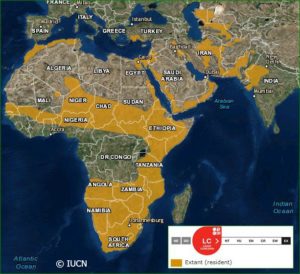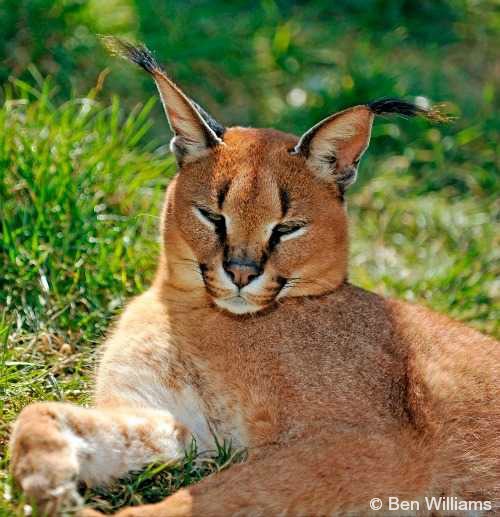- HB Length:61-105 cm (24-41″)
- Tail Length:19-34 cm (7.4-13″)
- Height:40-50 cm (16-20″)
- Weight:6-20 kg (13-44 lbs)
- Pop. Trend: Unknown
Although they are called ‘desert lynx’, Caracals Caracal caracal have longer legs, a more slender body, and the tail is considerably longer than true lynx. They also lack the ruff of hairs around the face which are so predominant in the northern cats. Melanistic Caracals have been reported, though only rarely.
The word Caracal means ‘black ears’ in Turkish. Large, tapering ears with five cm erect tufts of black hair, used for communication, are the most unique feature of this cat.
Black-backed ears, dark spots on both sides of the muzzle, black spots above the eyes and a black stripe from the eye to the nose break up an otherwise uniform tawny-brown to brick-red colouring. Eyes are large and yellow brown. The short, dense coat is slightly longer and whiter on the underside. Females are smaller than the males.
Distribution

Essentially an animal of dry regions, the Caracal has a wide habitat tolerance and is widely distributed. They are found in woodlands, savannahs and acacia scrub throughout Africa; jungle scrub and deserts in India; and arid, sandy regions and steppes in Asia.
Their historical range mirrors that of the Cheetah Acinonyx jubatus and both coincide with the distribution of several small desert gazelles. They are called ‘gazelle cats’ by nomads in North Africa.
Home ranges of three males in Namibia averaged 316.4 km2, and an Israeli study found ranges averaging 220.5/km2, indicating the low number of prey species in arid landscapes. In a well watered coastal protected area of South Africa, radio telemetry studies found adult male home ranges to be 31-65/km2, with those of females’ being 4- 31/km2. Males have a home range that overlaps those of several females.
Ecology
As a desert animal, they can survive long periods without drinking. During the hot hours of the day, they rest in crevices, and hunt mainly in the cooler morning, night and evening hours. Their gait is similar to that of the Cheetah, but they are not sprinters, and take to the trees if pursued by dogs. Although they can be considered the fastest cat of their size, their hunting technique is the stalk and spring method like that of the domestic cat.
Caracals are remarkable jumpers, and can jump up to 3 meters (10 feet) into the air to knock flushed birds down with their paw. Ten to a dozen pigeons at one time can be taken this way, and the Caracal was once tamed and trained for bird hunting in India and Iran. This is the origination of the expression ‘to put a cat amongst the pigeons’. They were put in an arena containing a flock of pigeons, and wagers were made to see how many they would take down. They were also used to hunt antelope, hares, and foxes, much like the Cheetah.
A kill is often dragged into dense cover where it can be eaten without disturbance. Large prey animals are covered with grass after the initial feeding, to be consumed later. New grass or fruit is also sometimes eaten, probably for the moisture content.
Like most species of cat, the Caracal is predominantly nocturnal, travelling up to 20 km per night in search of food. Sleeping is done in burrows, rock crevices or thick bush, sometimes in trees. Vocalizations are few, mainly growls and spits in anger, and a loud barking sound used to call their partners. As with other desert animals, their sight and hearing are very good and they have a moderate sense of smell.
Reproduction
Caracals are solitary animals, and come together only for mating. In the eastern Transvaal of Southern Africa, the peak birth time for Caracal kittens is July and August. After a 78 – 81 day gestation, one to six kittens weighing 198 – 250 grams are born in a burrow, crevice, or dense patch of brush lined with fur and feathers. Newborns are darker and greyer than the adults, with reddish belly spots that fade as they age. The kittens can open their eyes on the first day of life, but they are not completely open for six to 10 days. When they are about three weeks old, the mother takes them from the birth burrow to another location, and continues to move the family on a regular basis. At four to five weeks of age the young are very active and make a chirping, birdlike vocalization. They are weaned at about ten weeks, and remain with their mother for up to a year. Sexual maturity is reached around 12 – 16 months.
Conservation
The actual number of Caracal in the wild is unknown. They are considered rare or threatened in Asia and North Africa. In central and southern Africa they are considered widespread and hunted as a poultry raiders or shot on sight wherever they are found. Poisoned carcasses which kill a variety of carnivores are also put out by ranchers to kill predators.
Between 1931-1952, an average of 2,219 Caracals per year were killed in South Africa during predator control operations. Namibian farmers responding to a government questionnaire reported killing up to 2,800 Caracals in 1981.
A study in the United Arab Emirates found 11 of 12 Caracal scats contained domestic goats or sheep, as natural prey numbers were low or absent. In a protected area of Iran, cape hare and rodents made up the bulk of the Caracal diet, and there was no predation on livestock reported. As well, no livestock remains were found in 200 scats in a South African park where wild prey was abundant.
Caracals are most numerous in South Africa and Namibia, where their range is expanding, possibly due to extirpation of black-backed jackals by farmers. An additional threat is severe habitat loss. As people move further into their territory, their prey species are driven out and persecution increases.
Range map IUCN Red List
Updated 2014
![]()
The Cats For Africa webpage has a wonderful selection of Caracal videos, all well worth watching!


22 Responses